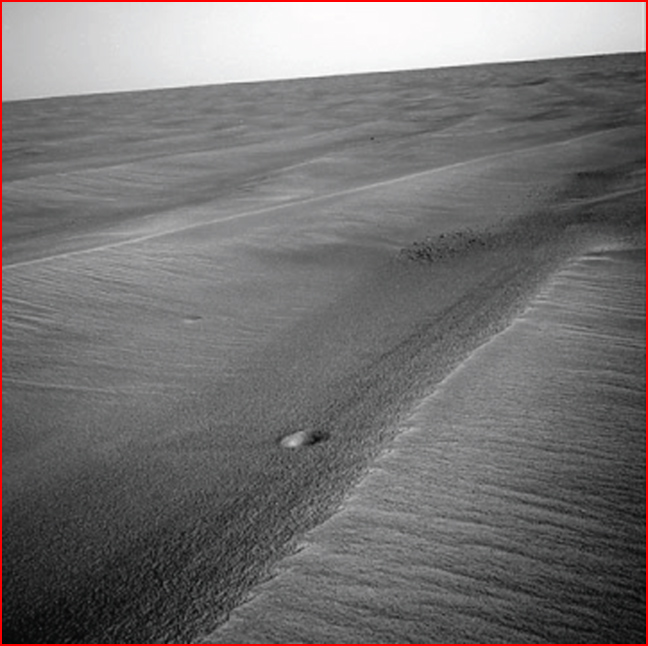
home •
about •
essential guide •
picture of the day •
thunderblogs •
news •
multimedia •
predictions •
products •
get involved •
contact
picture of the day archive subject index
Tiny craters in Meridiani Planum. Credit: NASA/JPL Mars Exploration Rover, Opportunity
Apr 25, 2008
Mars in Miniature
Mars exhibits many formations whose shapes are independent of size. Could the scalar nature of electrical discharges be the reason?Previous Thunderbolts Picture of the Day articles discussed the large dune fields on Mars, the channels carved into them and the craters with which they are associated. In many instances where standard geological and astrophysical theories have come to no conclusions, we have concluded that electricity is the one unifying factor that explains how they all may have formed.
Most of the structures have been examined through the use of satellite imagery returned from orbital cameras, so there has been a need to look at the surface more closely. The Mars Exploration Rover (MER) B, Opportunity, has been surveying the Martian terrain for more than three years. On its way to the rim of Victoria crater, it rolled through fields of dark dunes and white, polygonal blocks of stone. The stone blocks have been dubbed "cobbles" or "pavement" because they are so flat compared to the undulating piles of gravel that surround them. The flat stones are unique in many respects:
They are split in regular polygons with wide cracks that are most often filled with hematite "blueberries."
They exhibit fractures that radiate in concentric arcs from what appear to be hollow impact zones.
They appear to have been roughly etched, or eroded away on top, but the cracks have edges that are sometimes razor-sharp. Many are undercut.
They seem to have been sliced off at ground level from large blocks composed of the same material. The big chunks also contain blueberries in great concentration.
In the image at the top of the page, there is a small crater visible in the edge of a dune with another even smaller version further in the distance. The crater in the foreground is less than half a meter in diameter. The one in the background is less than three centimeters deep.
Both craters are smooth and undistorted with rounded rims and no blast debris, so they can't be micro-meteor impacts.
Criss-crossing the foreground crater are dark streaks. The edges of the dune are scalloped and striated. A closer look reveals that they are covered in small dendritic ridges.
The dunes look compacted and solid, rather than wind-blown and frangible. The wheel tracks left by the MER have well-defined edges as if they rolled through damp sand. The grains are relatively large and uniform in size and are mostly iron oxide.
The dunes are layered with light and dark bands. There are bright edges on many of the small ridges that lead down to etched channels.
It is unusual that dark hematite is so intimately bound up with white silicon-dioxide rock. Could there be a connection between silica and hematite? Could the same electric arcs that are thought to have carved the Red Planet transmute elements - reforming the atomic structure of silicon (with 28 particles in its nucleus) into that of iron (with 56)?
In the space-based images of Mars there are craters measuring hundreds of kilometers in diameter with dune fields 800 meters high that have identical structure to these one-meter ripples. On Mars the large and the small, as well as the light and the dark are starkly defined. Are they two results of one cause?
By Stephen Smith
___________________________________________________________________________Please visit our Forum
The Electric Sky and The Electric Universe available now!

|
|

|
EXECUTIVE EDITORS:
David Talbott, Wallace Thornhill
MANAGING EDITORS:
Steve Smith, Mel Acheson
CONTRIBUTING EDITORS: Michael Armstrong, Dwardu Cardona,
Ev Cochrane,
C.J. Ransom, Don Scott, Rens van der Sluijs, Ian Tresman
WEBMASTER: Brian Talbott
Copyright 2007: thunderbolts.info
![]()
home •
thunderblogs •
forum •
picture of the day •
resources •
team •
updates •
contact us

